Final EAPP Q1 Module 10 - EAPP 11 PDF

| Title | Final EAPP Q1 Module 10 - EAPP 11 |
|---|---|
| Course | hope (P. E)- 11 |
| Institution | Arellano University |
| Pages | 24 |
| File Size | 1.2 MB |
| File Type | |
| Total Downloads | 571 |
| Total Views | 889 |
Summary
English – Grade 7English for Academicand Professional PurposesQuarter 1A Novel Concept with Visuals/Graphic AidsCS_EN11/12A-EAPP-Ig-j-11Applied Subject - English for Academic and Professional Purposes Supplementary Learning Material Quarter 1 – A Novel Concept with Visuals/Graphic Aids First Edition...
Description
11 English for Academic and Professional Purposes Quarter 1 A Novel Concept with Visuals/G CS_EN11/12A-EAPP-Ig-j-
Aid
Applied Subject - English for Academic and Professional Purposes Supplementary Learning Material Quarter 1 – A Novel Concept with Visuals/Graphic Aids First Edition, 2020 Republic Act 8293, section 176 states that: No copyright shall subsist in any work of the Government of the Philippines. However, prior approval of the government agency or office wherein the work is created shall be necessary for exploitation of such work for profit. Such agency or office may, among other things, impose as a condition the payment of royalties. Borrowed materials (i.e., songs, stories, poems, pictures, photos, brand names, trademarks, etc.) included in this Learner Material are owned by their respective copyright holders. Every effort has been exerted to locate and seek permission to use these materials from their respective copyright owners. The publisher and authors do not represent nor claim ownership over them. Published by the Department of Education Secretary: Leonor Magtolis Briones Undersecretary: Diosdado M. San Antonio Development Team of the Module Author Language Reviewer Content Editor Illustrator Layout Artist
: : : : :
Marjorie D.G. Gregorio, MAEd Fernando A. Dionisio, Jr. Noime D. Villaverde Alexander L. De Lazo, MAEd Ruenel D.G. Gregorio
Management Team: Gregorio C. Quinto, Jr., EdD Chief, Curriculum Implementation Division Rainelda M. Blanco, PhD Education Program Supervisor - LRMDS Agnes R. Bernardo, PhD EPS-Division ADM Coordinator Glenda S. Constantino Project Development Officer II Jay Arr V. Sangoyo EPS – English Joannarie C. Garcia Librarian II Department of Education, Schools Division of Bulacan Curriculum Implementation Division Learning Resource Management and Development System (LRMDS) Capitol Compound, Guinhawa St., City of Malolos, Bulacan Email address: [email protected]
2
11 English for Academic and Professional Purposes Quarter 1 A Novel Concept with Visual/Graphic Aids CS_EN11/12A-EAPP-Ig-j-24
Introductory Message For the Facilitator: Welcome to the English for Academic and Professional Purposes Supplementary Learning Material (SLM) on A Novel Concept with Visual/Graphic Aids. This module was collaboratively designed, developed and reviewed by educators both from public and private institutions to assist you, the teacher or facilitator in helping the learners meet the standards set by the K to 12 Curriculum while overcoming their personal, social, and economic constraints in schooling. This learning resource hopes to engage the learners into guided and independent learning activities at their own pace and time. Furthermore, this also aims to help learners acquire the needed 21st century skills while taking into consideration their needs and circumstances. In addition to the material in the main text, you will also see this box in the body of the module:
Notes to the Teacher This contains helpful tips or strategies that will help you in guiding the learners
As a facilitator, you are expected to orient the learners on how to use this module. You also need to keep track of the learners’ progress while allowing them to manage their own learning. Furthermore, you are expected to encourage and the learners as they do the tasks included in the module. For the Learner: Welcome to the English for Academic and Professional Supplementary Learning Material (SLM) on A Novel Concept with Visual/Graphic Aids. This module was designed to provide you with fun and meaningful opportunities for guided and independent learning at your own pace and time. You will be enabled to process the contents of the learning resource while being an active learner. This module has the following parts and corresponding icons: This will give you an idea of the skills or competencies you are expected to learn in the module.
1
This part includes an activity that aims to check what you already know about the lesson to take. If you get all the answers correctly (100%), you may decide to skip this module. This is a brief drill or review to help you link the current lesson with the previous one. In this portion, the new lesson will be introduced to you in various ways; a story, a song, a poem, a problem opener, an activity or a situation. This section provides a brief discussion of the lesson. This aims to help you discover and understand new concepts and skills. This comprises activities for independent practice to solidify your understanding and skills of the topic. You may check the answers to the exercises using the Answer Key at the end of the module. This includes questions or blank sentence/paragraph to be filled in to process what you learned from the lesson. This section provides an activity which will help you transfer your new knowledge or skill into real life situations or concerns. This is a task which aims to evaluate your level of mastery in achieving the learning competency. In this portion, another activity will be given to you to enrich your knowledge or skill of the lesson learned. This contains answers to all activities in the module.
At the end of this module, you will also find: References- This is a list of all sources used in developing this module. The following are some reminders in using this module: 1. Use the module with care. Do not put unnecessary mark/s on any part of the module. Use a separate sheet of paper in answering the exercises. 2. Don’t forget to answer What I Know before moving on to the other activities included in the module. 3. Read the instructions carefully before doing each task. 4. Observe honesty and integrity in doing the tasks and checking your answers. 5. Finish the task at hand before proceeding to the next. 6. Return this module to your teacher/facilitator once you are through with it. If you encounter any difficulty in answering the tasks in this module, do not hesitate to consult your teacher or facilitator. Always bear in mind that you are not alone. 2
We hope that through this material, you will experience meaningful learning and gain deep understanding of the relevant competencies. You can do it!
Learning Competency: Presents a novel concept or project with accompanying visuals/graphic aids (CS_EN11/12A_EAPP-Ig-j-24). At the end of this module, you are expected to: 1. define what a novel is; 2. explain a novel concept; and 3. create visuals/graphic aids to present a novel concept.
Directions: Vocabulary: Identify the term being defined in each statement. Choose the letter that corresponds to the correct answer. _______
1.
_______
2.
_______
3.
_______
4.
_______
5.
_______
6.
It refers to ‘different to anything known before’. a. project b. idea c. novel It is about something new, interesting and after seeming slightly strange. a. Story b. Novel c. Tragedy It is the meaning of the Latin “novellus”. a. new, young, fresh b. meaty, spicy c. Experimental ideas It is a noun meaning piece of work. a. project b. presentation c. illustration A _______________ is intended to achieve a particular aim. a. proposal b. intention c. project _____________ is a piece of planned work or activity that is completed one a period of time. a. Continuous plan b. Project proposal c. Arts and Design 3
_______
_______
_______
_______
7.
It can be a project to propose. a. Watching a Teleserye b. Climbing a mountain c. Constructing a building or facility 8. Implementing a new business process and marketing is an example of_______________. a. concept b. principle c. idea 9. It means acquiring a new or modified data system. a. Novel concept b. conclusion c. information from a reading 10. It is a plan or intention. a. decision making b. retention c. concept
Directions: Re-arrange the word/s found in the box to form a meaningful sentence. Write your answer on the line provided for. 1. ____________________________________________________________________ for
a
is structuralism
me
idea different
2. ____________________________________________________________________ center the
has firmly
to kept
original idea its
Innovatively, the word ‘novel’ is not just a very compelling one. A good concept goes beyond the ordinary to offer something fresh and nothing if not generic and brand. It is also different from anything known before. It is new, interesting and after seeming slightly strange. A novel concept is planned carefully. In addition, it is intended to achieve a particular aim: a research or construction project (Brooks 2015).
4
A novel concept is a tool for data analysis and knowledge processing. It is a formal concept analysis and has been applied to many fields. For senior high school students, it is more on developing a new product or service. Structuralism, therefore, is very extensive to plan, to design and should be careful to process within. The conception of any novel concept or project is to help sell or publicize a commodity, yet to share in a public a new concept in corporate and hospitable treats among students.
Examples of Novel Concepts with Visuals and Aids 1. Developing a new product/ service a. Innovative projects a.1 Novel task cards: The students will visit different task stations that challenge them to analyze a text through different lenses. a.2 Theme park project: It is to design a theme park based upon the literary elements of a selection. a.3 Book Headlines: It simultaneously reports key information. The headline tells what the article is about. a.4 Character Instagram: It is more on the social media platform. It also allows users to create magazine artistically. a.5 Novel Podcast Project: It is about creating a podcast episode on a book novel of their choice.
2. A concept for constructing a facility. A concept design represents the design teams’ initial response to the project brief. It is followed by detailed design or developed design during which all the main components of the building and how they fit together are described. 3. A concept for designing a new transportation vehicle a. The Action of transport is defined as a particular improvement of a thing from point A (a place in space) to a point B. 5
b. Modes of transport include air, land (rail and road), water, cable, pipeline and space. The field can be divided into infrastructure vehicle and operations. 4. A concept for acquiring a new or modified data system a. The acquisition of information systems can either involve external servicing or relying on internal development or modification. b. It offers on demand access via internet to services furnished by a provider that runs data contents with the plan for the long term. c. It should support business initiative. That, on a long-term plan, there should be the requirements of various individuals for data workers to top management. d. Essential applications are identified and project priorities are set.
5. Implementing a new business process a. Implementation in putting up a business is a process of executing a plan on policy so that a concept becomes a reality. b. Business owners and managers should communicate clear goals and expectations, and supply employees with the resources needed to help the company achieve its goals. c. Implementation of a plan, however, brings about change meant to help improve the company to solve a problem. The changes can occur to policies, organization, products, and services.
Independent Activity 1 Directions: True or False: Write T if the statement is true, F if false. Write your answer on the line before each number. _____ _____
1. The term ‘novel’ in writing a concept means “fresh and unique”. 2. A novel concept is a scientific tool for data analysis and knowledge processing. 6
_____ 3. Writing a novel concept brings in fantastical elements. _____ 4. A novel concept in any field is not just a very compelling one. _____ 5. After approving a concept, a novel one is different from anything known before. ______ 6. A novel concept for a field or study has main feature. ______ 7. A piece of plan will be completed in a long period of time. ______ 8. Innovative novel concept allows users to create imaginatively and artistically. ______ 9. Concept design represents a teams’ initial response to the project. ______ 10. In a business novel concept, essential requirements are not clearly identified.
Independent Assessment 1 Identify what is being referred to in the following statements. Write your answer on the line provided before each number. _______________ _______________ _______________ _______________ _______________ _______________ _______________ _______________ _______________ _______________
1.
An innovative plan that challenges the group in analyzing a text through different lenses 2. A novel project designing a theme based upon the elements of a selected piece 3. Another novel project about creating a podcast episode 4. Focused on headline in a project which tells what the article is about 5. A social media platform that allows users to create reading materials 6. Represents the design teams’ initiative response to the project brief 7. It should be followed by detailed design 8. The field in any novel project can be divided into infrastructure and _____________. 9. The acquisition of informal systems can either involve external or _______________ development of the project 10. The process of executing plan or policy
Independent Activity 2: Reading A Novel Concept Directions: Read the text below from the Institute of Environmental Studies of Free University of Amsterdam. Innovative/Improvised Novel Concept of the Impact and Risk Assessment Hydro-meteorological risks such as floods and droughts can have huge repercussions on the well-being of human society, both in terms of human suffering and economic impact. Risk assessment form the basis for decision making in the management 7
of hydro-meteorological risks. With risks assessment approaches becoming more prevalent, there is a clear need for improved knowledge under methods to address and assess the risks. In solution, Imprex further developed four promising novel concepts related to hydrometeorological risk assessment. In addition to the meteorological development, the concepts were tested in case study areas with stakeholders in order to gain experience on their practical applicability and to illustrate their usefulness for decision making.
Novel concept 1: Climate variability and flood/drought risks Our capability to prepare for disasters is challenged by large uncertainties and our limited understanding of important driving forces of hydro-meteorological hazards, such as climate variability. Large-scale indices of climate variability (e.g. El Niño Southern Oscillation or the North Atlantic Oscillation) are often used for seasonal forecast models to predict upcoming weather conditions in monthly to seasonal scale. However, little knowledge exists about the relationships between these large-scale indices and their impacts on society, such as flood damages and crop productivity. Combining improved weather variability predictions with empirical models on potential impacts creates opportunities for the management of hydro-meteorological risks. IMPREX explored the direct relationships between natural climate variability and flood and drought impacts, allowing for fast and practical impact assessments on the basis of known climatic oscillations. The developments can feed into risk outlooks and early warning systems in areas that are prone to floods and droughts for a variety of sectors (i.e. agriculture, hydropower, emergency aid, etc.). The seasonal predictions can enable better disaster prevention, mitigation and preparedness by stakeholders and can improve the climate resilience and sustainability of these sectors. Crop yields and flood impacts derived from large scale climate indices Probabilities of occurrence of high-impact extremes are linked to governing large scale climatic patterns. Advanced machine learning techniques have been used to relate a number of influential climate patterns to the occurrence of both, floods and crop yield anomalies in different European subdomains. The techniques are designed to extract information from past observations that could be used to make a forecast of the probability of major future impacts encompassing a time range of a few months. Also, prediction of anomalies in sugar beet production can be made, for some regions, up to six months before the start of harvesting season. This work was carried out in partnership with the European Joint Research Centre. Some of these results are used in the IMPREX risk outlook displaying an assessment of risks for hydrological impacts at a lead time of a couple of months, derived from multiple lines of evidence. In a follow-up study carried out by IVM, the 8
method was extended by including bottom-up local knowledge, which implies an active use of stakeholder information and people’s perceptions of risk. The work shifts the focus from forecasting hazards towards impacts, which is a promising approach to generate meaningful outlooks and early warnings for targeted stakeholders.
Novel concept 2: Future weather and compound events Conventionally, to assess climate risks, univariate climate statistics (e.g. return periods of precipitation or water levels) are derived from either historical observations or (downscaled) climate model simulations. However, this approach does not give insight into future changes in the joint occurrence of two or more events (e.g. extreme precipitation and a storm surge at the same time), also known as compound events. A realistic simulation of compound events requires the use of high resolution weather models, as opposed to coarser climate models, to have the right (spatial and temporal) resolution and processes relevant for extreme weather events. This can be run under the climate conditions of interest (such as a future climate) and coupled to impact models (hydrologic and/or hydraulic). This new concept, called Future Weather (FW), has been developed to complement the traditional approach in climate impact research. The concept adds to the physical understanding of drivers of high impact hydro-meteorological events by using numerical weather prediction models to project high impact weather events in a future climate. Moreover, Future Weather provides information to stakeholders at the local scale where climate change is experienced as changes in high-impact weather. The concept may also aid in increasing awareness of climate change and its impacts by visualising future weather cases and relating these to present day experiences. Within IMPREX, FW was applied in case studies in the Netherlands and the UK. Risks to compound flooding were analysed in the current and future climate in consultation with the stakeholders. Inclusion of compound events in risk analysis The need to consider compound events has been documented in an IMPREX policy brief for European Flood Risk management and flagged by authoritative publications by IPCC. With help from IMPREX a new European COST action DAMOCLES has been launched to promote awareness and systematic analysis. In IMPREX, work has been carried out including the development of new model data sets and analysis concepts, targeted at studying its relevance for flood risk management in a number of smaller Dutch catchment areas and municipalities. The notion of compound events is well appreciated by many stakeholders involved in IMPREX and is a component of the commercial portfolio of consultancy firms like HKV. 9
In order to be absorbed in the stakeholders’ decision processes, the advantages of this method ne...
Similar Free PDFs
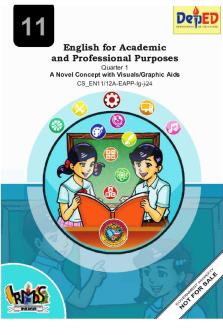
Final EAPP Q1 Module 10 - EAPP 11
- 24 Pages
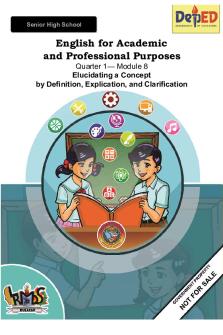
Final EAPP Q1 Module 8 - EAPP 11
- 30 Pages
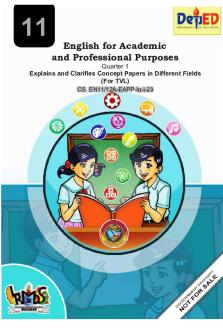
Final EAPP Q1 Module 9 - EAPP 11
- 22 Pages

EAPP- Q1- Module 5 - english
- 23 Pages

EAPP-Module-2 - Module
- 28 Pages
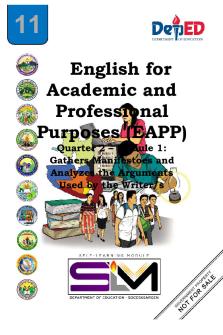
EAPP- Q2- Module 1 - english
- 22 Pages

EAPP Quarter 2 Module 5
- 70 Pages

EAPP Q2 Module 5 - Research
- 20 Pages

EAPP- Q2- Module 5 - english
- 20 Pages

EAPP TG - Research
- 207 Pages
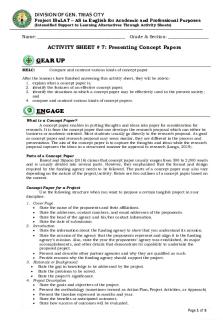
EAPP Q3-AS8-Concept Paper Final
- 5 Pages

Remedial sa EAPP GR
- 2 Pages

EAPP-O.C.-summative-q2-
- 2 Pages

EAPP Quarter-1-WEEK-1
- 19 Pages
Popular Institutions
- Tinajero National High School - Annex
- Politeknik Caltex Riau
- Yokohama City University
- SGT University
- University of Al-Qadisiyah
- Divine Word College of Vigan
- Techniek College Rotterdam
- Universidade de Santiago
- Universiti Teknologi MARA Cawangan Johor Kampus Pasir Gudang
- Poltekkes Kemenkes Yogyakarta
- Baguio City National High School
- Colegio san marcos
- preparatoria uno
- Centro de Bachillerato Tecnológico Industrial y de Servicios No. 107
- Dalian Maritime University
- Quang Trung Secondary School
- Colegio Tecnológico en Informática
- Corporación Regional de Educación Superior
- Grupo CEDVA
- Dar Al Uloom University
- Centro de Estudios Preuniversitarios de la Universidad Nacional de Ingeniería
- 上智大学
- Aakash International School, Nuna Majara
- San Felipe Neri Catholic School
- Kang Chiao International School - New Taipei City
- Misamis Occidental National High School
- Institución Educativa Escuela Normal Juan Ladrilleros
- Kolehiyo ng Pantukan
- Batanes State College
- Instituto Continental
- Sekolah Menengah Kejuruan Kesehatan Kaltara (Tarakan)
- Colegio de La Inmaculada Concepcion - Cebu

![[ Amaleaks. Blogspot.COM] EAPP-111 Week 1-7](https://pdfedu.com/img/crop/172x258/qk2qo1ppzqrw.jpg)